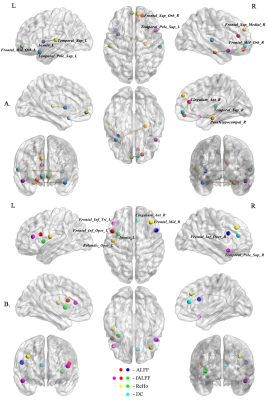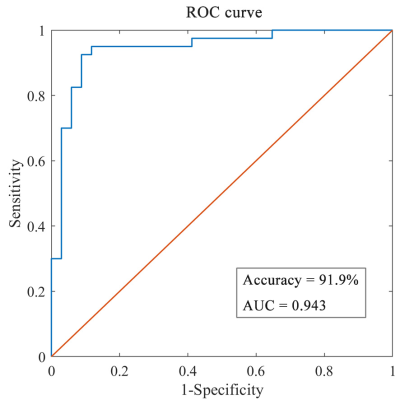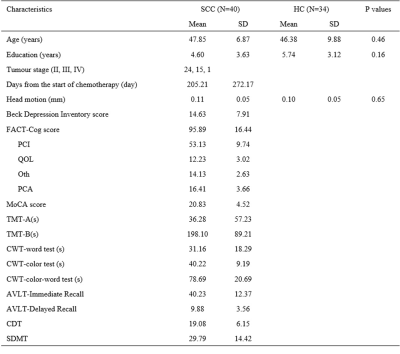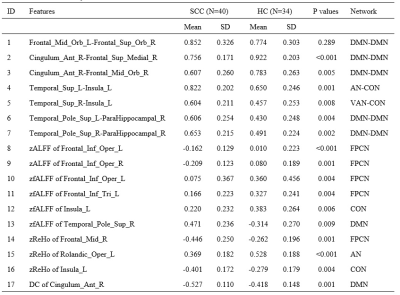1429
Classification of Chemotherapy-Related Subjective Cognitive Complaints in Breast Cancer Using Multi-Level Features of Functional MRI1Department of Radiology, The First Affiliated Hospital of Nanchang University, Nanchang, China
Synopsis
Chemotherapy-related cognitive impairment (CRCI), especially subjective cognitive complaints (SCC), had been often reported in breast cancer survivors, which affects their life and work. The identification of biomarkers for early diagnosis and prognosis prediction of SCC remains a crucial challenge of important clinical implications. The resting-state functional magnetic resonance imaging (rs-fMRI) has been widely used to detect abnormalities of brain activity in CRCI. The machine learning method combined with rs-fMRI features could effectively identify breast cancer survivors with chemotherapy-related SCC from healthy controls (HC).
INTRODUCTION
Breast cancer is the most common malignant disease that threatens women all over the world 1, and chemotherapy is one of the most important treatments. More than 50% of breast cancer survivors have cognitive impairment in many aspects, including memory, execution, attention and reaction speed, during or after chemotherapy which called CRCI, and more than half of them are mainly manifested as SCC 2,3, which seriously affects the ability to work and socialize 4. The rs-fMRI studies had confirmed that there were extensive abnormalities of local brain functional activities and connections in breast cancer survivors with CRCI 5-7. This study was aimed to using machine learning method to construct a support vector machine (SVM) model through muti-level rs-fMRI characteristics of, including functional network connectivity (FNC), amplitude of low frequency fluctuation (ALFF), fractional ALFF (fALFF), regional homogeneity (ReHo), voxel-mirrored homotopic connectivity (VMHC) and degree centrality (DC), which could effectively identify breast cancer survivors with chemotherapy-related SCC from breast cancer survivors before chemotherapy and HCs, and might provide potential neuroimaging biomarker for the accurate diagnosis and to detect the pathophysiological mechanism in CRCI.METHODS
Forty breast cancer survivors with SCC after receiving standard dosage chemotherapy and thirty-four age- and sex-matched healthy controls were recruited and underwent rs-fMRI scanning with 3.0-Tesla MRI Scanner using an eight-channel head coil. SCC were defined as self-reports of memory, execution, attention, processing speed and other cognitive impairment. The self-reports performance in survivors were assessed by the questionnaire of Functional Assessment of Cancer Therapy–Cognitive Function (FACT-Cog) 8 version 3 and Beck Depression Inventory 9. The objective cognition would be measured from different cognitive subdomains by the following six neurophysiological tests: (1) Montreal Cognitive Assessment (MoCA) Beijing version 10; (2) Trail Making Test (TMT) 11: It consists of two parts: A and B; (3) Stroop Color-Word Test (CWT) 12: There are three parts in this test: word test, color test and color-word test; (4) The Chinese version of Auditory Verbal Learning Test (AVLT) 13; (5) Symbol Digital Modalities Test (SDMT) 14; (6) Clock Drawing Test (CDT) 15. After rs-fMRI data preprocessing, based-on 90 brain regions of automated anatomical labeling (AAL) atlas, we calculated ALFF, fALFF, ReHo, VMHC and DC values in every regions of interest (ROI). The FNC was calculated by Pearson’s correlation of mean time series between every pair ROIs. Finally, we got 4005 FNC, 90 ALFF, 90 fALFF, 90 ReHo, 90 VMHC and 90 DC values as features. The feature selection was firstly performed by two sample t test on each variable between the SCC and HC group to retain the different variables (P <0.01). Then, we removed the variables with a strong pairwise correlation (0.65 as the correlation threshold) to weaken multi-collinearity. Last, we used the least absolute shrinkage and selection operator (LASSO) regression method with 10-fold crossing validation to choose the most discriminative features for classification. We constructed support vector machine (SVM) model with linear kernel to identify the state (SCC or HC) of each subject based on the selected features after LASSO and the permutation test (number of permutations: 5000) were applied to examine the robustness and validity of the model.RESULTS
Seventeen features (including 7 FNC, 2 ALFF, 4 fALFF, 3 ReHo and 1 DC) were selected. The accuracy and area under curve (AUC) of the SVM model built based on the 17 features was 91.9% and 0.943 respectively (permutation test: P < 0.0001).DISCUSSION
The SVM model with an excellent classification accuracy in this study suggested that these rs-fMRI features may be used as potential neuroimaging biomarkers to identify breast cancer survivors underwent chemotherapy with SCC from healthy controls. Furthermore, the screened features were mainly distributed in different brain networks, potentially indicating the altered functional activity of the network.CONCLUSION
These findings demonstrated an effective machine learning approach combined rs-fMRI characteristics could identify breast cancer survivors underwent chemotherapy with SCC from HC, providing the potential adjunctive approach to early diagnosis.Acknowledgements
This study was supported by the National Natural Science Foundation of China (Grant number: 81771808), the Key Science and Technology Financing Projects of the Jiangxi Provincial Education Department (Grant number: GJJ170033); and Jiangxi Province Key Research and Development Project (Grant number: 20192BBGL70034).References
1. Siegel R L, Miller K D, Jemal A. Cancer statistics, 2020. CA Cancer J Clin. 2020, 70(1): 7-30.
2. Lange M, Licaj I, Clarisse B, et al. Cognitive complaints in cancer survivors and expectations for support: Results from a web-based survey. Cancer Med, 2019. 8(5): 2654-2663.
3. Fitzmaurice C, Abate D, Abbasi N, et al. Global, Regional, and National Cancer Incidence, Mortality, Years of Life Lost, Years Lived With Disability, and Disability-Adjusted Life-Years for 29 Cancer Groups, 1990 to 2017: A Systematic Analysis for the Global Burden of Disease Study. JAMA Oncol. 2019, 5(12): 1749-1768.
4. Gutmann D H. Clearing the Fog surrounding Chemobrain. Cell. 2019, 176(1-2): 2-4.
5. Tao L, Lin H, Yan Y, et al. Impairment of the executive function in breast cancer patients receiving chemotherapy treatment: a functional MRI study. Eur J Cancer Care (Engl). 2017, 26(6).
6. Chen B T, Jin T, Patel S K, et al. Intrinsic brain activity changes associated with adjuvant chemotherapy in older women with breast cancer: a pilot longitudinal study. Breast Cancer Res Treat. 2019, 176(1): 181-189.
7. Miao H, Chen X, Yan Y, et al. Functional connectivity change of brain default mode network in breast cancer patients after chemotherapy. Neuroradiology. 2016, 58(9): 921-8.
8. Wagner L I, Sweet J, Butt Z, et al. Measuring patient self-reported cognitive function: Development of the Functional Assessment of Cancer Therapy–Cognitive Function Instrument. J Support Oncol. 2009, 7: W32-W39.
9. Bosscher R J, Koning H, Van Meurs R. Reliability and validity of the Beck Depression Inventory in a Dutch college population. Psychol Rep. 1986, 58(3): 696-8.
10. Yu J, Li J, Huang X. The Beijing version of the Montreal Cognitive Assessment as a brief screening tool for mild cognitive impairment: a community-based study. BMC Psychiatry. 2012, 12: 156.
11. Llinas-Regla J, Vilalta-Franch J, Lopez-Pousa S, et al. The Trail Making Test. Assessment. 2017, 24(2): 183-196.
12. Spreen O, Strauss E. A Compendium of Neuropsychological tests : Administration, Norms and Commentary. 2007.
13. Rey A. L'examen clinique en psychologie. [The clinical examination in psychology.]. Oxford, England: Presses Universitaries De France. 1958: 222-222.
14. Smith A. Symbol digit modalities test. Western Psychological Services Los Angeles. 1973.
15. Brodaty H, Moore C M. The Clock Drawing Test for dementia of the Alzheimer's type: A comparison of three scoring methods in a memory disorders clinic. Int J Geriatr Psychiatry. 1997, 12(6): 619-27.
Figures



Table 1 Demographical and clinical data of all subjects
Abbreviations: FACT-Cog, Functional Assessment of Cancer Therapy–Cognitive Function; PCI, perceived cognitive impairment; QOL, impact of perceived cognitive impairments on quality of life; Oth, comments from others; PCA, perceived cognitive abilities; MoCA, Montreal Cognitive Assessment; TMT, Trail Making Test; CWT, Stroop colour-word test; AVLT, Rey auditory verbal learning test; CDT, Clock Drawing Test; SDMT, Symbol Digital Modalities Test.

Table 2 Characteristic of the 17 features for discriminating breast cancer survivors after chemotherapy with SCC and healthy controls
Abbreviations: DMN, default mode network; AN, auditory network; CON, cingular-opercular network; VAN, ventral-attention network; FPCN, frontal-parietal control network.